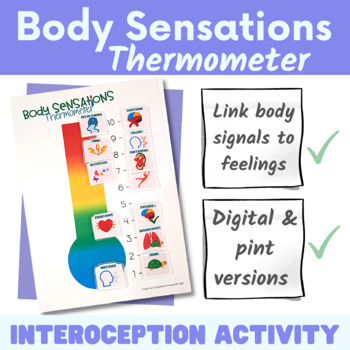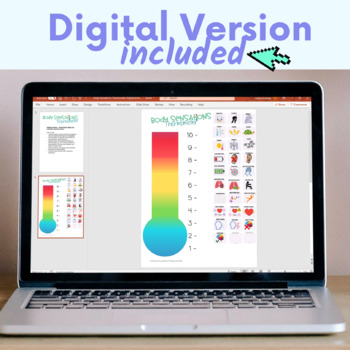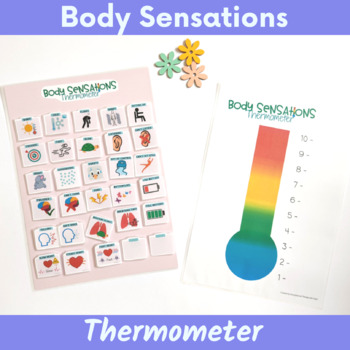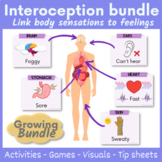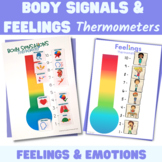Body Sensations Thermometer - Interoception and Emotional Regulation Activity
- Zip
- Internet Activities
What educators are saying
Also included in
- Are you looking for engaging interoception activities / games to help your students identify their own emotions? This best selling interoception bundle is full of excellent social and emotional learning (SEL) resources to support students to develop their ability to recognise their own internal bodyPrice $37.80Original Price $47.25Save $9.45
- These engaging social and emotional activities are designed to help students identify different feelings and body sensations and begin to identify the different intensities of sensations and emotions. The body sensations and feelings thermometers come in digital and print formats. What's included:FePrice $4.55Original Price $6.50Save $1.95
Description
The body sensations thermometer is an engaging interoception and emotional regulation activity designed to support students to develop their ability to notice body sensations, link body sensations to feelings and develop students’ ability to distinguish between small, medium, and large sensations.
I made this resource because I couldn’t find an easy and compelling way to visually show the difference between small, medium, and large body sensations and feelings. When I introduced the thermometer to my kids, it helped them conceptualize this big topic!
This is a fun, simple and visual interoception tool that support students to:
- Notice and identify body sensations
- Identify different feelings within themselves
- Measure how they are feeling
- Distinguish between different intensities of sensations. For example, differences between small, medium and large sensations (e.g. breathing slowly (small sensation), steady heart beat (medium sensation) or out of control (large sensation).
- Support students to identify when they are starting to experience feelings like worry and frustration and implement strategies before the feelings escalate and become difficult to manage.
What’s included
- Printable thermometer (pdf)
- 30 body sensation cards (pdf) including:
- Fast - Slow - Shaky - War - Cold - Sweaty - Butterflies - Sore - Heavy
- Floppy - Listening - Can’t listen - Low battery - Full battery - Can’t sit still
- Sitting up - Breathing slowly - Breathing fast - Out of control - Focused
- Fast heartbeat - Slow heartbeat - Steady heartbeat - Can’t think
- Focused brain - Soft voice - Yelling - Goosebumps
- A digital interoception activity with thermometer and visuals (power point) - PowerPoint slide is movable and interactive. You can use it on a screen or digitally with students.
- Tip sheet for teaching this activity & discussing body sensation thermometers (pdf)
- 2 x blank cards (for students to write and draw their own sensations)
Printable interoception worksheets - how to use
- With scissors cut out each body sensation visual
- Select a sensation. Now identify what emotion this sensation might belong too.
- Identify where the sensation belongs on the thermometer, e.g. is it a small, medium or big sensation? Attach to thermometer.
- Continue above process until finished
Digital interoception activity - how to use
- Student selects a body sensation (sensations can be moved and the size is changeable).
- Ask students to identify what emotion/s this sensation might belong to.
- Identify where the sensation belongs on thermometer, e.g. is it a small, medium or big sensation? You can use numbers as a guide to support this.
- Click on picture, now drag /move sensation and place on thermometer
- Continue same process with remaining sensations.
*Please note that we all experience sensations differently. You may not need to use all sensations provided or you might like to draw your own describing words and pictures to the blank squares provided.
Disclaimer
These activities are intended for general use. This activity is not intended to replace the advice of a physician or occupational therapist. Information provided should not be used for diagnostic or training purposes. If you require specific support contact your physician or OT. Stop any activity if you are unsure about a child’s reaction or ability.
Copyright Occupational Therapy with Soph
All rights reserved by author. This resource is licensed only for the educator or clinician who purchased it. You may share with your own students or case load.
Questions
Any questions, comments, feedback or requests please reach out to me via TPT or at sophia.occupationaltherapy@gmail.com

